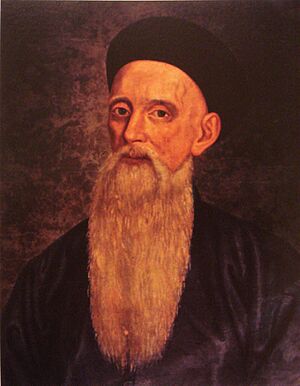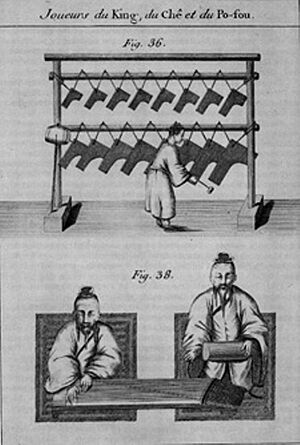Jean Joseph Marie Amiot facts for kids
Quick facts for kids
Jean Joseph Marie Amiot
|
|
|---|---|

Painting of Amiot, anon.
|
|
| Born | February 8, 1718 |
| Died | October 8, 1793 (aged 75) |
| Occupation | Jesuit missionary |
Jean Joseph Marie Amiot (Chinese: 錢德明; pinyin: Qián Démíng; February 8, 1718 – October 8, 1793) was a French Jesuit priest. He worked in Qing China during the time of the Qianlong Emperor.
Amiot was born in Toulon, France. When he was 19, he joined the Society of Jesus, a group of Catholic priests. After becoming a priest in 1746, he wanted to work in a mission far away. He was sent to China and left France in 1749. He arrived in Beijing in 1751 and stayed there for the rest of his life.
Amiot helped connect scholars in Europe with those in China. His letters taught Europeans a lot about Chinese culture. He also translated Chinese books into French. His most famous translation was The Art of War by Sun Tzu. This was the first time this important book was translated into a Western language.
Contents
Amiot's Early Life
Jean Joseph Marie Amiot was born in Toulon, France, on February 8, 1718. His father, Louis Amiot, was a royal notary. His mother was Marie-Anne Serre. Jean was the oldest of ten children. He had five brothers and five sisters.
One of his brothers, Pierre-Jules-Roch Amiot, became a high-ranking naval officer. His sister, Marguerite-Claire, became an Ursuline nun. Amiot stayed in touch with both of them throughout his life.
After studying philosophy and theology, Amiot joined the Society of Jesus in Avignon. This was on September 27, 1737. He spent two years learning to be a Jesuit.
Later, he taught at Jesuit colleges in different cities. These included Besançon, Arles, Aix-en-Provence, and Nîmes. In Nîmes, he taught rhetoric, which is the art of speaking and writing well. He finished his studies in 1748 and became a priest on December 22, 1746.
Arriving in China
Amiot asked the head of the Jesuits, Franz Retz, to send him on an overseas mission. He really wanted to go to China. He had even written to his brother about this wish. In 1749, he left France. Two Chinese Jesuits, Paul Liu and Stanislas Kang, traveled with him. They had been studying in France and were returning home. Sadly, Kang died during the sea journey before reaching China.
They arrived in Macau on July 27, 1750. The Jesuits in Beijing told Emperor Qianlong about Amiot's arrival. The emperor ordered them to be brought to the capital city. On March 28, 1751, they left Macau for Guangzhou. They arrived there five days later. They left Canton on June 2 and finally reached Beijing on August 22.
Once in Beijing, Amiot was put in charge of a children's group. He also spent time learning the Chinese language. He took on a Chinese name, Qian Deming (錢德明). He also started wearing Chinese clothing to fit in with the local culture. In 1754, Amiot hired a young Chinese man named Yang Ya-Ko-Pe as his helper. He taught Yang in the European style. Yang worked with Amiot for over thirty years until he died in 1784.
Challenges for the Jesuits
In 1762, the French government ordered the suppression of the Society of Jesus. This meant the Jesuits were banned in France, and their property was taken. The Jesuit mission in China, however, was protected by the Qianlong Emperor for a while.
But then, on July 21, 1773, Pope Clement XIV officially ordered the end of the Society of Jesus worldwide. This order reached the French Jesuits in China on September 22, 1775. The Jesuits in Beijing accepted the order. They left the Society of Jesus and became regular priests.
King Louis XVI of France wanted to keep the French mission in China going. So, he sent them money and appointed François Bourgeois to manage things. Amiot was chosen to take Bourgeois's place if he was away.
After this, Amiot focused more on his writing. He kept in touch with Henri Bertin, who was France's foreign minister. Amiot's letters were published from 1776 to 1791. They appeared in a collection called Mémoires concernant l’histoire, les sciences, les arts, les mœurs et les usages des Chinois. He also wrote to other European groups, like the Imperial Academy of Sciences and the Royal Society.
Later Years and Passing
After Bourgeois died in 1792, Amiot began visiting the graves of his fellow Jesuits. He would pray and think there. He also carved messages on their tombstones. News about the French Revolution in France made him very upset. His health, both physical and mental, got worse. By September 1792, he had to stop visiting the tombs.
In 1792, Britain sent a group of diplomats to China. This was the Macartney Embassy, led by George Macartney. Their goal was to open new trading ports and set up a permanent mission. Macartney wanted to meet Amiot in Beijing. However, Amiot was too ill to meet him. Instead, he sent Macartney a painting of himself and a letter. This was delivered on October 3, 1793. Amiot gave Macartney advice and suggested he leave China.
On October 8, 1793, Amiot heard the sad news that King Louis XVI had been executed. He held a special Mass for the dead king. Amiot died on the same night, October 8, or perhaps the next day, October 9, 1793.
Amiot's Important Works
In 1772, Amiot's translation of Sun Tzu's The Art of War was published. It also included a translation of the Yongzheng Emperor's Ten Precepts. Amiot was the first person to translate The Art of War for Western readers. The next translation of this work into a Western language didn't happen until 1905.
Amiot could also speak Manchu, which was the language of the emperor. He wrote a Manchu-French dictionary. It was published from 1789 to 1790 with help from Bertin. Prince Hongwu, a member of the Qing imperial family, praised the dictionary. Amiot also wrote a Manchu grammar book, but it was never published.
While in China, Amiot also did scientific observations and experiments. For example, he kept records of the weather in Beijing. These records were published by Charles Messier in 1774. He also tried to build a hot air balloon. However, Prince Hongwu discouraged him. The prince worried about the danger of flying and spreading this new discovery.
Amiot and Music
Amiot knew how to play the harpsichord and the flute. He tried to impress Chinese listeners by playing music by French composers. These included pieces like Rameau's Les sauvages. However, these attempts were not successful. When he asked Chinese musicians what they thought, they said his music was not for their ears, and their ears were not for his music. Some experts today question if this story is completely true.
In 1754, Amiot sent his translation of Guyue Jingzhuan (古樂經傳) to Paris. This was a book by Li Guangdi about Chinese music. Amiot later admitted that his translation had mistakes and was not complete. Jean-Philippe Rameau used this work in his own music book in 1760. But Rameau's ideas about Chinese music harmony were incorrect.
Amiot's own work on Chinese music, Mémoire sur la musique des Chinois, was published twice. This happened in 1779 and 1780. His extra notes for the work were not published until 1997. He also sent collections of Chinese music and instruments to France. In 1777, he sent a Sheng, a Chinese instrument. This helped in the creation of the harmonica in Europe.


